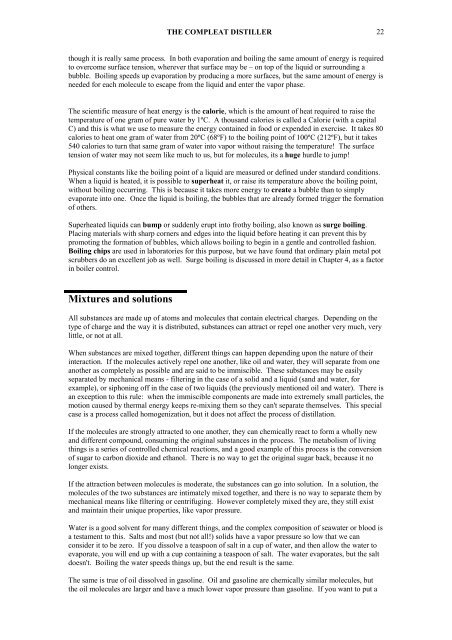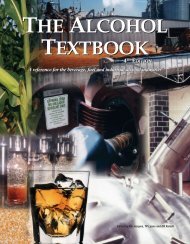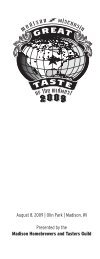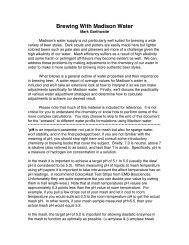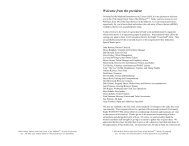The Compleat Distiller
The Compleat Distiller
The Compleat Distiller
Create successful ePaper yourself
Turn your PDF publications into a flip-book with our unique Google optimized e-Paper software.
THE COMPLEAT DISTILLER 22<br />
though it is really same process. In both evaporation and boiling the same amount of energy is required<br />
to overcome surface tension, wherever that surface may be – on top of the liquid or surrounding a<br />
bubble. Boiling speeds up evaporation by producing a more surfaces, but the same amount of energy is<br />
needed for each molecule to escape from the liquid and enter the vapor phase.<br />
<strong>The</strong> scientific measure of heat energy is the calorie, which is the amount of heat required to raise the<br />
temperature of one gram of pure water by 1ºC. A thousand calories is called a Calorie (with a capital<br />
C) and this is what we use to measure the energy contained in food or expended in exercise. It takes 80<br />
calories to heat one gram of water from 20ºC (68ºF) to the boiling point of 100ºC (212ºF), but it takes<br />
540 calories to turn that same gram of water into vapor without raising the temperature! <strong>The</strong> surface<br />
tension of water may not seem like much to us, but for molecules, its a huge hurdle to jump!<br />
Physical constants like the boiling point of a liquid are measured or defined under standard conditions.<br />
When a liquid is heated, it is possible to superheat it, or raise its temperature above the boiling point,<br />
without boiling occurring. This is because it takes more energy to create a bubble than to simply<br />
evaporate into one. Once the liquid is boiling, the bubbles that are already formed trigger the formation<br />
of others.<br />
Superheated liquids can bump or suddenly erupt into frothy boiling, also known as surge boiling.<br />
Placing materials with sharp corners and edges into the liquid before heating it can prevent this by<br />
promoting the formation of bubbles, which allows boiling to begin in a gentle and controlled fashion.<br />
Boiling chips are used in laboratories for this purpose, but we have found that ordinary plain metal pot<br />
scrubbers do an excellent job as well. Surge boiling is discussed in more detail in Chapter 4, as a factor<br />
in boiler control.<br />
Mixtures and solutions<br />
All substances are made up of atoms and molecules that contain electrical charges. Depending on the<br />
type of charge and the way it is distributed, substances can attract or repel one another very much, very<br />
little, or not at all.<br />
When substances are mixed together, different things can happen depending upon the nature of their<br />
interaction. If the molecules actively repel one another, like oil and water, they will separate from one<br />
another as completely as possible and are said to be immiscible. <strong>The</strong>se substances may be easily<br />
separated by mechanical means - filtering in the case of a solid and a liquid (sand and water, for<br />
example), or siphoning off in the case of two liquids (the previously mentioned oil and water). <strong>The</strong>re is<br />
an exception to this rule: when the immiscible components are made into extremely small particles, the<br />
motion caused by thermal energy keeps re-mixing them so they can't separate themselves. This special<br />
case is a process called homogenization, but it does not affect the process of distillation.<br />
If the molecules are strongly attracted to one another, they can chemically react to form a wholly new<br />
and different compound, consuming the original substances in the process. <strong>The</strong> metabolism of living<br />
things is a series of controlled chemical reactions, and a good example of this process is the conversion<br />
of sugar to carbon dioxide and ethanol. <strong>The</strong>re is no way to get the original sugar back, because it no<br />
longer exists.<br />
If the attraction between molecules is moderate, the substances can go into solution. In a solution, the<br />
molecules of the two substances are intimately mixed together, and there is no way to separate them by<br />
mechanical means like filtering or centrifuging. However completely mixed they are, they still exist<br />
and maintain their unique properties, like vapor pressure.<br />
Water is a good solvent for many different things, and the complex composition of seawater or blood is<br />
a testament to this. Salts and most (but not all!) solids have a vapor pressure so low that we can<br />
consider it to be zero. If you dissolve a teaspoon of salt in a cup of water, and then allow the water to<br />
evaporate, you will end up with a cup containing a teaspoon of salt. <strong>The</strong> water evaporates, but the salt<br />
doesn't. Boiling the water speeds things up, but the end result is the same.<br />
<strong>The</strong> same is true of oil dissolved in gasoline. Oil and gasoline are chemically similar molecules, but<br />
the oil molecules are larger and have a much lower vapor pressure than gasoline. If you want to put a


